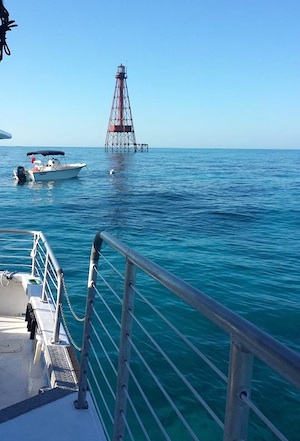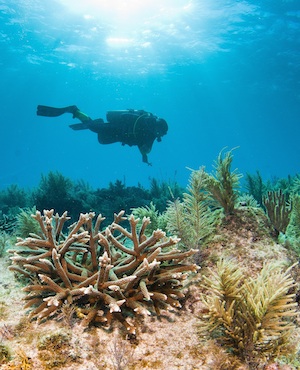Florida Keys National Marine Sanctuary Marks 25th 'Birthday'
FLORIDA KEYS — For divers, snorkelers, anglers and watersports enthusiasts, Nov. 16, 2015, is a significant date. It marks the 25th anniversary of the creation of the Florida Keys National Marine Sanctuary that protects 2,900 nautical miles of waters surrounding the Keys island chain.
Sanctuary waters are popular with Keys visitors and residents for activities including boating, diving and snorkeling, swimming, deep-sea and backcountry fishing, dolphin-watching, paddleboarding, kiteboarding, kayaking and simply relaxing. The sanctuary protects a spectacular and unique ecosystem with shallow seagrass beds, mangrove-fringed islands and the world's third-largest barrier coral reef that collectively support more than 6,000 species. In addition, it is the final resting spot of culturally important shipwrecks — some dating back centuries.
"If you come to the Florida Keys you can see more fish and diversity of fish that is tough to find anywhere else in the Caribbean or Gulf of Mexico," said Sean Morton, the sanctuary's superintendent.
It all began in 1989 when three large freighters ran aground on the coral reef within a 17-day period. There had been talk at the time of slightly expanding the boundaries of already existing protected waters in the Keys, but the groundings led federal lawmakers to push a bill through the U.S. Congress that would protect all waters surrounding the islands.
President George H.W. Bush signed the Florida Keys National Marine Sanctuary and Protection Act Nov. 16, 1990.
Administered by the National Oceanic and Atmospheric Administration, the sanctuary's boundaries stretch from Biscayne National Park near Miami, Fla., to the Dry Tortugas (70 miles west of Key West).
Keys waters offer world-class diving and snorkeling at the reef and on shipwrecks. The warm water and generally excellent visibility mean underwater explorers can see the vibrant colors of sea fans, corals and a wide array of tropical fish. Sea turtles, moray eels and rays also are regulars at reefs.
The island chain's Blue Star operators promote responsible diving and snorkeling at the reef, with emphasis on not touching or removing corals and using mooring buoys so boats don't have to drop anchors that might damage corals.
The sanctuary has put in place no-take zones, covering a small percentage of the waters, which are designed to allow important species of fish an opportunity to spawn and grow to help improve size and populations.
Kayaking and paddleboarding are great ways to see the beauty of the sanctuary's seagrass beds full of juvenile marine life or observe birds and other wildlife on pristine islands.
The sanctuary works with other government agencies, universities and private entities on research projects to get better science about fish populations and other marine life topics.
"We have done our best to put in management tools to protect the environment," Morton said. "We will continue to try to make this special place even better to sustain a healthy marine ecosystem for our children and our children's children to enjoy."
Florida Keys National Marine Sanctuary information: floridakeys.noaa.gov/
Florida Keys visitor information: fla-keys.com or 1-800-FLA-KEYS
Social: Facebook • Twitter • KeysVoices.com • YouTube

Keys waters offer world-class diving and snorkeling at the reef where warm water and generally excellent visibility mean underwater explorers can see the vibrant colors of sea fans, corals and a wide array of tropical fish. Sea turtles, moray eels and rays also are regulars at reefs, such as the shallow yet abundant Sombrero Reef off Marathon.

The island chain's Blue Star operators promote responsible diving and snorkeling at the reef, with emphasis on not touching or removing corals and using mooring buoys so boats don't have to drop anchors that might damage corals. Image: Tim Grollimund/CRF

